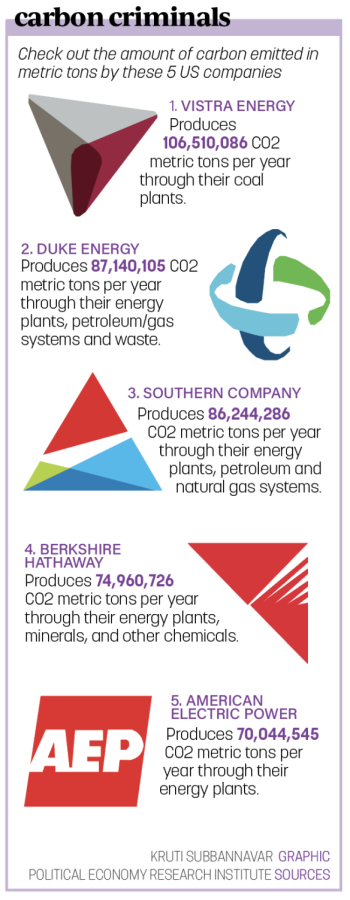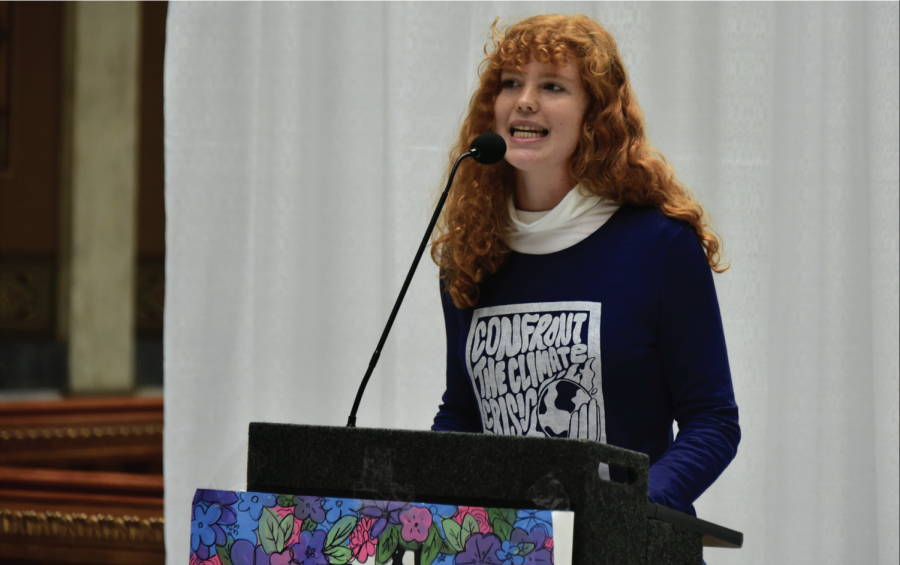Senior Luca Kim, who identifies as a Christian, said she believes there exists an important intersection between Christ and the environment. According to Kim, faith has helped her connect with the Earth.
“Church is a super-important part of my life,” Kim said. “I really found a community there, and going back and establishing myself in the faith helps me see so many issues that are going on in my life and in the world in a new perspective. That includes issues with the environment.”
Many individuals like Kim have found a connection to environmentalism through their faith. Organizations like the Evangelical Environmental Network, the Episcopal Church and Interfaith Power and Light were formed to engage religious communities in environmental stewardship. Hoosier Interfaith Power and Light (HIPL), an Indiana chapter of the national organization, recently launched its Thriving Faith Communities Initiative, encouraging Indiana congregations to reduce their energy consumption by 25% by 2025.
Elsa Barron, a community organizer with HIPL, said it is also normal for young people to struggle with their faith and its connection to their everyday beliefs.
“I initially grew up in a pretty conservative evangelical church community where there wasn’t a lot of conversation about environmental issues at all,” she said. “A lot of it had to do with the connection of environmentalism to science, and there was this overarching fear of science jeopardizing the faith.”
However, people like Kim said there is room for environmental action within the faith.
“My church affiliation really believes in the idea of ‘creation care,’ and looking after everything that God gave us, which includes the environment. So there is definitely an established area for environmentalism within the church, but we just need to look for it,” she said.
Barron said she agreed, and said her personal experiences changed as she branched out of her local community and learned more about “creation care.”
“I went to college and studied biology, but at the same time I was in this theology class where I read a theology by Pope Francis, called ‘On Care for Our Home,’ which talked about the importance of caring for our collective environment. This was an epiphany, which brought science and its relation to environmentalism and the faith into coexistence with each other,” she said.
The term “creation care,” referenced by both Kim and Barron, was first coined in the early 2000s, and is closely related to the religious belief that one must care for God’s creation. According to HIPL, every major religion includes a mandate to care for creation, allowing people of all faiths to be united to protect the environment. Kim said she felt inspired by creation care ideology.
“It helped me realize that there is not only one understanding of God,” Kim said. “Personally, I believe it is important to protect what God gave us, which includes the environment, and it is important to work with the others who are a part of that environment to take care of it.”
This idea is shared by those of other faiths as well. Sarah Alhaddad, a junior who practices Islam, said that mannerisms of her faith project the same ideals.
“I’m a Muslim, and because of that, there kind of an emphasis in Islam that as humans on this earth, we’re here to take care of the earth and the heavens, which are said to be even more important creations than humans themselves,” she said. “And because of that, we’re kind of seen as caretakers—or I guess you could use the word ‘custodians’—to make sure that the earth is being treated properly.”
Barron said although faith can be extremely diverse, it is important to show unity in the face of issues like the climate crisis which threaten the shared environment.
“I think there is a wide range of opinions, but there is also a huge community of people who care about this issue, which I saw first hand through my work,” Barron said. “I went to the U.N. Climate Change session this past year and had the chance to work with all these amazing organizations to propel our interfaith goal of climate justice, this time on a global scale, as we fought to ensure that smaller nations are equipped with the ability to maintain environmental codes in the face of an increasingly industrialized world.”

According to Alhaddad, these aims of environmental protection, including Barron’s goal of climate justice, can also be achieved by taking more everyday measures, such as the ones which are present as a result of her faith. For example, Alhaddad said that in her daily life, in accordance with her Muslim faith, she ensures that she consumes only halal food, which is prepared in humane ways.
“Environmental care is very emphasized in the Quran—and there’s a lot of verses about it, like over 200 verses—in our religious text about taking care of the earth and the responsibility humans have to do that. And I guess it just kind of deepens that responsibility and that ‘I really should do this,’ you know,” she said.
Kim, Barron, and Alhaddad said they agreed the concept of creation care is an important directive for younger generations to continue.
“The environment is already so unstable,” Kim said, “with difficulties raging in every part of the world. A massive movement such as Christianity, which is present in every region of the world, has the ability to unite people and lead a charge against environmental destruction.”
Barron said she has seen how much creation care unites young people.
“Even in youth centers like Notre Dame, there was this campus-wide initiative to make the theme for the 2021-2022 school year, one about environmental action and “creation care.” That just goes to show how many students on campus petitioned on a united front for this theme, so that even the dean would see it as an important initiative. Young people everywhere do care about this, and it is important that we continue this initiative because of how uniting it is.”



















![Joseph Broman, Mu Alpha Theta sponsor, grades tests for his honors precalculus/trigonometry class. Broman said, “I’m retiring from the Math Club next year and I’m just going to do Mu Alpha Theta so I can focus on that one and we can do more [speaker series] first semester.”](https://hilite.org/wp-content/uploads/2024/03/IMG_9502-1200x900.jpg)











![British royalty are American celebrities [opinion]](https://hilite.org/wp-content/uploads/2024/03/Screenshot-2024-03-24-1.44.57-PM.png)




















![Review: “The Iron Claw” cannot get enough praise [MUSE]](https://hilite.org/wp-content/uploads/2024/04/unnamed.png)
![Review: “The Bear” sets an unbelievably high bar for future comedy shows [MUSE]](https://hilite.org/wp-content/uploads/2024/03/unnamed.png)
![Review: “Mysterious Lotus Casebook” is an amazing historical Chinese drama [MUSE]](https://hilite.org/wp-content/uploads/2024/03/0.webp)
![Thea Bendaly on her Instagram-run crochet shop [Biz Buzz]](https://hilite.org/wp-content/uploads/2024/03/IMG_0165-1200x838.jpg)
![Review: Sally Rooney’s “Normal People,” is the best book to read when you are in a time of change [MUSE]](https://hilite.org/wp-content/uploads/2024/03/20047217-low_res-normal-people.webp)
![Review in Print: Maripaz Villar brings a delightfully unique style to the world of WEBTOON [MUSE]](https://hilite.org/wp-content/uploads/2023/12/maripazcover-1200x960.jpg)
![Review: “The Sword of Kaigen” is a masterpiece [MUSE]](https://hilite.org/wp-content/uploads/2023/11/Screenshot-2023-11-26-201051.png)
![Review: Gateron Oil Kings, great linear switches, okay price [MUSE]](https://hilite.org/wp-content/uploads/2023/11/Screenshot-2023-11-26-200553.png)
![Review: “A Haunting in Venice” is a significant improvement from other Agatha Christie adaptations [MUSE]](https://hilite.org/wp-content/uploads/2023/11/e7ee2938a6d422669771bce6d8088521.jpg)
![Review: A Thanksgiving story from elementary school, still just as interesting [MUSE]](https://hilite.org/wp-content/uploads/2023/11/Screenshot-2023-11-26-195514-987x1200.png)
![Review: When I Fly Towards You, cute, uplifting youth drama [MUSE]](https://hilite.org/wp-content/uploads/2023/09/When-I-Fly-Towards-You-Chinese-drama.png)
![Postcards from Muse: Hawaii Travel Diary [MUSE]](https://hilite.org/wp-content/uploads/2023/09/My-project-1-1200x1200.jpg)
![Review: Ladybug & Cat Noir: The Movie, departure from original show [MUSE]](https://hilite.org/wp-content/uploads/2023/09/Ladybug__Cat_Noir_-_The_Movie_poster.jpg)
![Review in Print: Hidden Love is the cute, uplifting drama everyone needs [MUSE]](https://hilite.org/wp-content/uploads/2023/09/hiddenlovecover-e1693597208225-1030x1200.png)
![Review in Print: Heartstopper is the heartwarming queer romance we all need [MUSE]](https://hilite.org/wp-content/uploads/2023/08/museheartstoppercover-1200x654.png)























![Review: Ladybug & Cat Noir: The Movie, departure from original show [MUSE]](https://hilite.org/wp-content/uploads/2023/09/Ladybug__Cat_Noir_-_The_Movie_poster-221x300.jpg)

![Review: Next in Fashion season two survives changes, becomes a valuable pop culture artifact [MUSE]](https://hilite.org/wp-content/uploads/2023/03/Screen-Shot-2023-03-09-at-11.05.05-AM-300x214.png)
![Review: Is The Stormlight Archive worth it? [MUSE]](https://hilite.org/wp-content/uploads/2023/10/unnamed-1-184x300.png)




